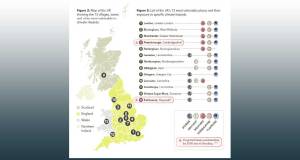- General
- Posted
Disappointment at new building energy standards
This article was originally published in issue 40 of Passive House Plus magazine. Want immediate access to all back issues and exclusive extra content? Click here to subscribe for as little as €10, or click here to receive the next issue free of charge
The latest update to England’s building regulations on energy and ventilation was released in December, and was greeted with widespread disappointment. The government published the interim Part L and Part F for non-domestic buildings, and the Fabric Energy Efficiency Standard (FEES) for homes, both of which will come into force in June. The full ‘Future Homes/ Future Buildings’ standards are due to take effect in 2025.
The majority of respondents to spring 2021’s 132-question consultation urged the government to increase its ambition on decarbonisation, but the government stuck to its original proposals in almost every case. The only real welcome was given to changes in Part F relating to ventilation in larger non-domestic buildings. These proposals, aimed at “reducing the risk of transmission of infection via aerosols in non-domestic buildings”, included designing ventilation systems with 50 per cent “headroom” so that ventilation rates can be increased in times of high infection risk. There is also a requirement for new ventilation systems in offices to have “a means of monitoring the indoor air quality”, for example CO2 monitoring.
These changes were promoted by experts on mitigating Covid infection risk. They were welcomed by Cath Noakes, professor of environmental engineering for buildings at the University of Leeds, and member of the UK government’s SAGE advisory group, as “the start of a process to make sure we have better buildings going forward.”
But reaction to the proposals for Part L were in stark contrast. There was widespread dismay that calls for stronger action fell on deaf ears. As LETI, the London Energy Transformation Initiative, put it: “The government has largely ignored the advice of built environment professionals in response to its proposed changes to building standards on energy use.”
There is also a requirement for new ventilation systems in offices to have "a means of monitoring the indoor air quality".
For example, 78 per cent of respondents selected the option to “go further” than the suggested 27 per cent CO2 reduction relative to 2013 standards, but the government stuck with this target nonetheless.
For the Fabric Energy Efficiency Standard for homes, around 70 per cent of respondents called for the government to go further than its two specification options. The government nonetheless stuck with one of its proposed standards, choosing ‘full’ FEES rather than option two, which was FEES with a 15 per cent reduction in overall efficiency. The government also failed to increase its ambition on airtightness. The department stuck with an air permeability backstop of 8 m3/h.m2 at 50 Pascals, despite the fact that “one of the most common comments” was that the permeability requirements should be improved.
The government also introduced primary energy as a new compliance metric for non-domestic buildings alongside emissions (as calculated in SAP). This was a highly unpopular proposal with an absolute majority of respondents rejecting it, including on grounds that it was confusing, and that the primary energy factors set out favoured high-carbon gas over electricity.
SAP under review
A review of SAP – the compliance calculation method for domestic buildings — is already underway. In 2021, the government commissioned a “scoping report” from consultancy Etude. The review ‘Making SAP and RdSAP fit for Net Zero’ was drawn up in consultation with a wide field of experts, said Etude.
Etude’s Thomas Lefevre, who led the review, shared the findings at an event hosted by Woodknowledge Wales last November.
Lefevre told the delegates: “The SAP and [in] particular, EPC system is seen by many as a serious obstacle to genuine, effective decarbonisation.
“We need the right metrics and the right tools, but EPCs and SAP are a very poor way to measure energy efficiency. There’s a big problem here, if policymakers simply set EPC targets and think job done.”
High up in the report’s concerns was the notional dwelling approach. “You can have two buildings with a very different form factor, one atrocious, one really good,” Lefevre said. “If you look at the actual space heating demand you see a huge difference. A building with a poor form factor might need twice as much space heating as another. But if they are built to the same specification SAP gives the impression they perform the same.”
Other problems flagged with SAP include the way carbon factors are out of date before new editions of SAP are even published, which is seen as completely counter-productive if SAP is intended to drive low-carbon design.
“At the moment you are still using a carbon factor of electricity which is more than three times what it is in reality, let alone what it will be in 20 years time. This is a tragic failure of SAP,” Lefevre said.
The Etude report is now being considered by another consortium led by BRE which “is working with stakeholders to consider the Etude recommendations and how to implement them”, according to the government SAP website.
Related items
-
 September’s AECB environmental construction conference seeks to spark debate among industry experts
September’s AECB environmental construction conference seeks to spark debate among industry experts -
 Climate report warns overheating crisis threatens UK
Climate report warns overheating crisis threatens UK -
 Sustainable building leaders crowned at Exemplar Awards
Sustainable building leaders crowned at Exemplar Awards -
 Barratt launches record passive house scheme
Barratt launches record passive house scheme -
 Green homes and finance join forces for growth
Green homes and finance join forces for growth -
 Irish and British associations unite for conference as passive house explodes
Irish and British associations unite for conference as passive house explodes

